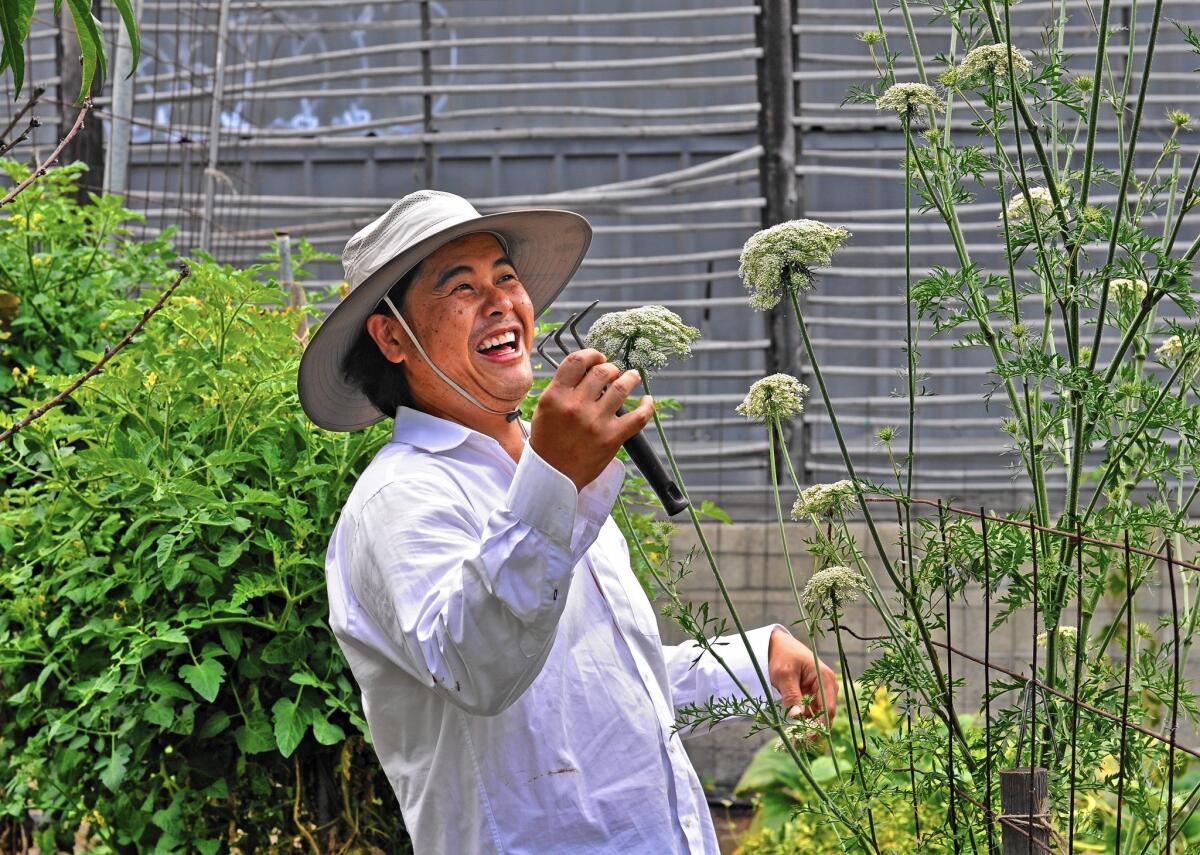Those items on the menu? Why, they’re right out here in the garden

Once upon a time, it was unusual to have chefs who shopped at farmers markets, who established relationships with growers and whose menus often read more like pages from the Seed Savers catalog than what’s for dinner. Now having a “market-driven” menu is common, even expected, especially in Los Angeles, where there are neighborhood farmers markets every day of the week and many of the farmers who supply the best restaurants in the country have farms that are only an hour or two away.
These days you’re as likely to find this town’s chefs gossiping over purslane and hoja santa at Bill Coleman’s market booth as you are downing after-service drinks at the Varnish. Some are even growing their own produce. Because, as chefs have been drawn to increasingly local and seasonal ingredients, it make sense that they’d look for their own gardens. Why wander around the countryside foraging when you can plant your own?
For the last two years, Alma chef Ari Taymor has been commuting three times a week from his downtown restaurant to Venice, where he has a dedicated experimental garden. “We looked around for a rooftop or a lot downtown,” says Taymor about finding a garden for Alma. “But there was so much red tape.” Instead he found Courtney Guerra, a culinary school grad who discovered that she liked growing food more than cooking it.
Guerra works about 1,000 square feet of land around a house in Venice; she rents the studio in the back, where she also has a makeshift greenhouse. On rotating beds, Guerra grows caraway, French sorrel, lovage, borage, lemon balm and rau ram. “Everything that comes out of this garden is Alma’s,” says Guerra. “It’s an expression of the restaurant.” Every dish at Alma has at least something from Guerra’s garden, as Taymor adjusts his cooking to sync with the growing seasons.
On a recent day, the sky overcast from the marine layer, Taymor talked shop with Guerra. She picked green caraway seeds for the evening’s menu, loading a bin with the marigolds that the chef will put into a dish with uni, burrata, caviar and an English muffin. He checked on the baby cucumbers, hidden under protecting restaurant deli cups. The two plan the crops and keep an availability list on a Google doc, and one or both harvest every day the restaurant is open. The garden, says Taymor, “allowed the food to become what it was.”
Not too far away in Venice, Govind Armstrong has a much shorter commute to get to his dedicated garden: He just walks outside his restaurant, Willie Jane. Armstrong has a five-bed garden at his Baldwin Hills restaurant Post & Beam, so when he opened Willie Jane he wanted something bigger. “When we took this over,” says Armstrong of the Willie Jane location on Abbot Kinney Boulevard, “we looked at the roof and then saw a dirt lot next door. It was weeds and dirt and feral cats.”
Now that dirt lot is a curated garden run by Geri Miller of Cook’s Garden, who leases the land and works it for chefs who have subscriptions. The lot now includes not only beds for Willie Jane’s produce but also dedicated gardens for the Tasting Kitchen and Scopa Italian Roots and for bartenders Pablo Moix and Matt Biancaniello, as well as a neighborhood garden (with beds worked by local families), a greenhouse, a small retail nursery and a chicken house that produces eggs for the restaurants.
“When I’m on a long phone call,” says Armstrong, “I’ll be in the garden.” He works with Miller to decide what to plant and adjusts Willie Jane’s menu to what they can grow. On a recent morning, he pulled a few stray weeds from beds of pea and radish sprouts and fava beans, peppers that he’ll dry and smoke, collard greens and green beans that grew up the trellis to thread through the lights above the garden.
The eastern side of the restaurant acts as a wind screen for the garden and gives it shade from the hot sun. With the garden so near, Armstrong can just pick the vegetables when he wants them. “They don’t even go in the walk-in [refrigerator],” he says.
Perhaps the most dedicated of these garden-minded chefs is Gary Menes, who works his own 1/8-acre garden in Long Beach seven days a week.
“I spend more time here than at the restaurant,” says Menes (wearing a straw hat and clogs) on a recent Saturday morning as he picked produce for the night’s dinner menu. He’s had the garden — which is 15 minutes from his house and near his kids’ school — for almost two years, longer than the current iteration of his Koreatown restaurant Le Comptoir has been open. “The cooking starts in the garden,” says Menes, busy weeding a bed where he’s growing tiny frais de bois strawberries from seed.
“I plant for diversity and for flavor; I grow as a chef,” says Menes, who waters by drip irrigation daily and once a week from cistern water. What he’s growing now: banana peppers, blueberries, favas (for nitrogen), cauliflower (the root marrow is sautéed and glazed), celery root (he makes chips with the leaves), kohlrabi, Charentais melons, asparagus, corn, beets, lettuces under a blackberry bush, eight kinds of tomatoes. Menes also inherited mulberry, cherry, persimmon and peach trees. It’s amazing what you can cram into an eighth of an acre.
“This was part of the business plan for Le Comptoir,” he says, noting that without the garden he couldn’t afford to run a restaurant that’s little more than a 10-seat counter facing a kitchen where he and his few chefs cook, mostly on hot plates. “This,” he says, looking at the greenery, “sustains the restaurant.” Which, if you think about it, is what sustainability in restaurant terms should really mean.
More to Read
Eat your way across L.A.
Get our weekly Tasting Notes newsletter for reviews, news and more.
You may occasionally receive promotional content from the Los Angeles Times.







